Watercolor Wisdom – 6 Techniques that You Need to Try Before Giving Up!

This week I am writing to you who have always liked the idea of using more watercolors but whose experiments don’t often last long. Try these techniques to keep going and not giving up!
1) Doodle with a Brush
Dip a thin brush into the paint and start doodling! Add more paint to some areas so that the thickness of the line varies and evokes new shapes.
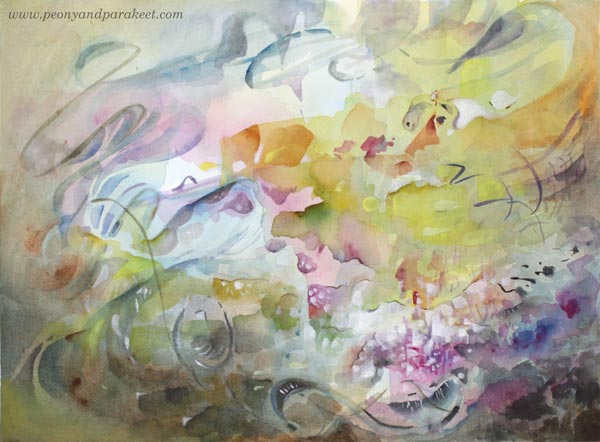
I have also used acrylic paints for finishing this piece called “Netfishing.”
2) Doodle with Masking Fluid
I don’t often recommend purchasing more art supplies to boost the motivation, but with watercolors, I highly recommend buying masking fluid. For example, Daniel Smith has a masking fluid that comes with handy applicators. You can just pick the bottle and start doodling. And while you are doing that why not fill the whole paper with them! Then add several layers of paint and remove the fluid gradually.

I have also used golden acrylic paint and colored pencils in this piece, called “Three Churches of St. Petersburg”.
3) Add Geometric Shapes to a Scenery
If all the elements are realistic, defined and “make sense,” you are underestimating the potential of watercolors. An easy way to push beyond the conventional is to add geometric shapes to a realistic theme, for example, to a scenery.
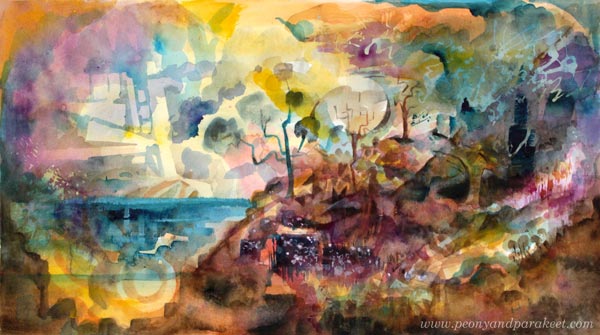
You can also paint vice versa: start with the geometry and then make it look like scenery.
4) Leave Blank Spots to Express the Light
Think about your painting as a collection of layers. Paint 6-10 layers so that every layer is a bit smaller than the previous one. Leave blank spots when painting the first layer. Focus on tiny details in the last layers. Let every layer dry before adding a new one.

5) Add Muddy Colors to Make the Brights Shine
Don’t be afraid of dark areas. If your work looks unfinished or the colors don’t shine no matter how much you add them, the solution is to add more really dark areas.

There are a lot of browns, greys, and blacks in these two small sceneries which make the color glow!

6) Pick One Dominating Color, but Use Many Tones of It
When applying paint on paper, add small drops of other colors too. Use the transparency of watercolors to get new tones: add watery paint, let dry, repeat!
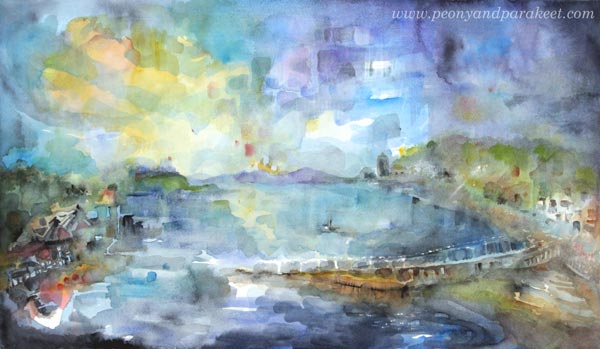
“Oban,” a small town in Scotland that left an impact on me. I could have painted the sky solid blue, as well as the water, but adding more variation of the color makes this painting.
Watercolor Journey – More Watercolor Wisdom for Self-Study!
The pictures and tips of this blog post are picked from my class Watercolor Journey. In this class, you will learn how to use the techniques and the imagination to express energizing sceneries. The fun thing is that these sceneries can be either realistic, or imaginative, or anything between. Sometimes the scenery is born with the technique. Other times painting is more about reconnecting with a happy memory. I have tried to make the videos as inspiring as possible so that you and your watercolors become a better match after each one.
>> Buy Watercolor Journey!
Minimalism in Creating – Making the Most of What You Have

Here’s my latest little study in watercolor, called “Ikebana.” I finished it today, but for a long time, it was just a piece of watercolor paper with random doodles and colored spots. I had started the piece in December 2016 when running a local art class. I had just painted mindlessly while discussing with the students and then left the piece unfinished.
Choosing Not to Toss Away
When I was holding the unfinished, ugly painting, I thought of my choices. I could toss the paper away and forget the thing. Or I could treat it as a treasure and make the most of it, despite the controlling straight lines that went through the page and other uninspiring details. To me, choosing to continue the painting, is usually always the better choice. Making the most what I have calms me down, gives me a sense of purpose, and positively challenges me. I don’t consider it so much as a choice of saving money or space but getting a peace of mind.
I have also noticed that when I work on with the old pieces, I find new ways to make them more expressive. That in turn, helps me to develop better classes and help my students. This time, I was inspired by April’s theme of Bloom and Fly – surreal art!
Getting back to old doodles also reminds me that even if I can’t make all the details work together, art is never fully perfect. Often the minor “mistakes” add personality and interesting tension to the piece.

I also like to store the finished pieces organized in folders.
Using Up Old Art Supplies
One of my favorite things is to organize art supplies once in a while. I try to find the best places for them so that they get used up. I find it much more pleasurable to buy new supplies when there’s the actual need. It’s also nice when I have had time to think what to purchase next.
So when I noticed that some pans of my White Nights watercolor set are getting empty, I decided to experiment and fill some with paint from the old tubes. I found an old gouache tube by Schminke, the pink that I totally love but had forgotten, and I hope it will keep on wetting well even after the pan is fully dried.

One of the pans that I made, the muddy green, is a color mix. It’s a color that I usually use for watercolor paintings to give brighter colors more power.
My Meditation – Cleaning Brushes
The longer I have created art, the more I have put a focus on my brushes. I used to buy them carelessly and toss them away once they didn’t seem to work anymore. But nowadays, I like to appreciate what I have and take time to clean the brushes carefully after each painting session.
The cleaner that I currently use is The Masters Brush Cleaner, recommended to me by my artist friend Eeva Nikunen. I have saved many old brushes by cleaning them properly with this cleaner, and I couldn’t even think of cleaning oil paint from the brushes with anything else.

This cleaner is a solid soap. You dip the brush in water and then rub the soap with the brush. Formerly, I only washed the brushes with warm water after watercolor painting. Now I use the cleaner for watercolor brushes too, and it’s lovely to begin a new painting session when my brushes are like new!
No Need for Inventing New Ideas
To me, looking old stuff with fresh eyes is one of the best things in art, and it applies to ideas as well. See “From Innovation to Experience” from 2014 and Origami from 2016-2018!
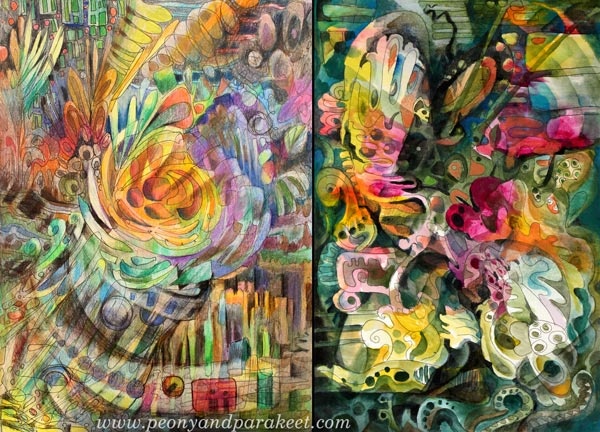
Is This Too Much Minimalism?
I was hesitant to write this blog post because I don’t want to take the joy out of buying new stuff and starting new art. I also enjoy that! But often the best cure for procrastination is to stop thinking what you don’t have and start using your creativity to make the most of what you already have. Bonding with the old supplies and ideas can give a sense of independence and freedom too.
“It’s not who you are that holds you back, it’s who you think you’re not.” – Artist Jean-Michel Basquiat
I heard this quote from one of the members of Bloom and Fly, and it feels appropriate here too!
Bloom and Fly – Get new inspiration and perspective to your art!
>> Sign up here!
Painting a Loose Scenery with Daniel Smith Watercolors

Last week, I did it. I bought some Daniel Smith watercolors because I had heard about them so much and for so long that I had to try them too. I bought the “Watercolor Essentials” set of 6 small tubes and a tube of Iridescent Scarab Red – a brownish red that has a green glow. Exciting!
Inspired by Ippolito Caffi
But what to paint? The idea came this week when I went to see Ippolito Caffi’s architectural paintings and landscapes at Sinebrychoff Art Museum in Helsinki. It’s the kind of art that I personally don’t like to create, but I enjoyed the exhibition. Here’s Piazza del Pantheon by Caffi, an oil painting on cardboard.

As said, realistic architectural urban scenes and landscapes are not what usually come to my mind when I start creating. But after watching a lot of scenes from Italy brought memories from my trip to Florence and Rome last summer. So why not pick a random photo of the trip and start painting?
Palazzo Doria Pamphilj

The photo that I quickly chose was taken at the inner court of Palazzo Doria Pamphilj, Rome. The palace has a wonderful art museum that I blogged in July 2017. I thought that I could use it as a loose reference and create something totally different, abstract perhaps. Painting a scenery with watercolors felt too traditional to me. So I just started splashing water and blue paint.

Scenery with Daniel Smith Watercolors
Daniel Smith watercolors are lively. Not only colors are lively but the pigment seems to travel quickly, and it creates wonderful effects.

Here’s my painting after playing with big brushes and water.
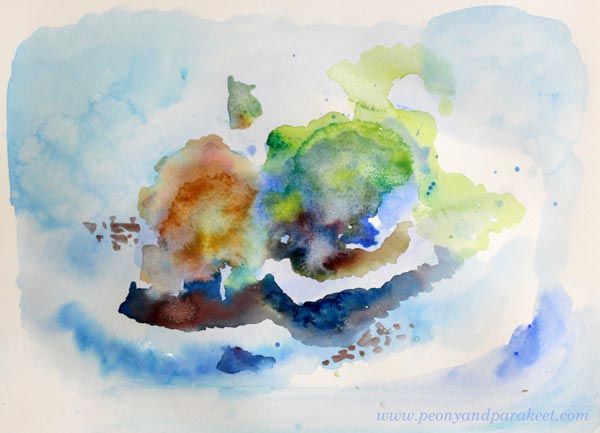
Then I changed to a water brush that is quite narrow. I love using this brush. It’s so easy to paint small details with it.

Iridescent Scarab Red looks interesting! Very different from any of the watercolors that I know. At this point, I thought about making a fantasy scene of some kind.

Time to loosen up!
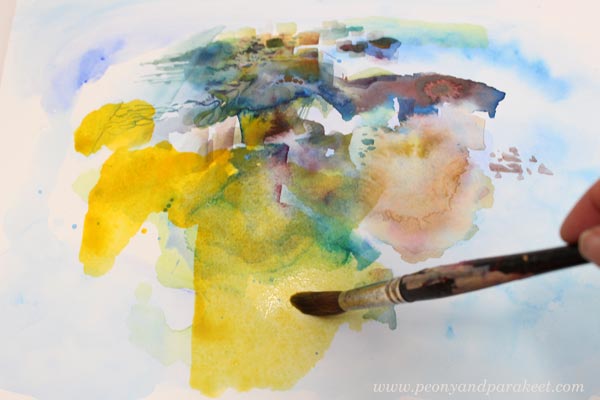
The more I painted, the more tempting it became to paint Palazzo Doria Pamphilj as I experienced it. It was a really hot summer day when I visited it. It’s located in the middle of busy Rome, yet its thick walls seem to isolate the museum from the city.

I let the image be visible while I was working but did not follow it to detail.

I found Daniel Smith’s watercolors easy and fun. I don’t like the color selection of the Essentials set so much, and the paints are really expensive compared to any other brand. The owner of the art supply store said that he likes to sell the essentials set at a fairly low price because once you try them, you are hooked and need some more. He may be right! But because I spend quite a lot of money in top quality oil paints, I might not buy more Daniel Smith shortly.
Finished Painting and Signature
The painting of Palazzo Doria Pamphilj became quite loose, but it’s ok. I enjoyed connecting with the memories, and this is a bit like a souvenir from the place.
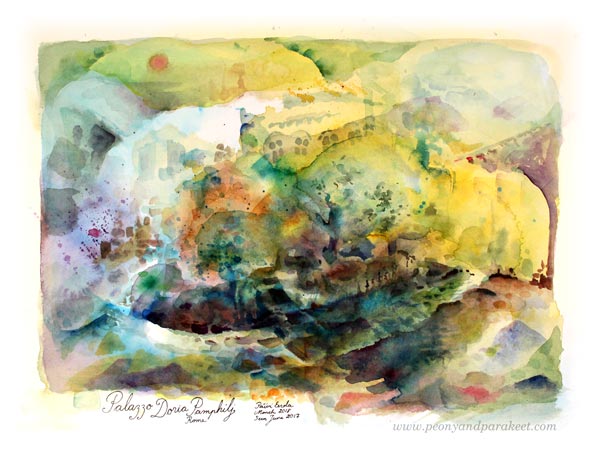
At my recent visit to the museum, I also saw Giovanni Battista Piranesi‘s amazing graphic works. They had beautiful signatures, so I also added one to the watercolor painting. I think it finishes the painting nicely.
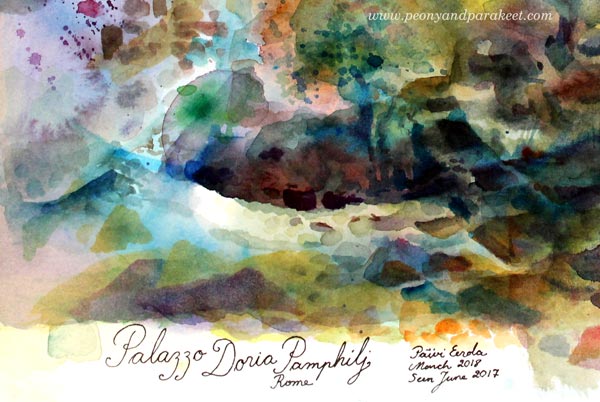
This project is a perfect example of how being a bit adventurous can open new ideas. Landscape and architectural painting don’t feel so boring to me anymore! I have ideas for next quick paintings too. This kind of exploration is not only fun but also important for the creativity. If you limit yourself to one theme, to one type of work, creating becomes tedious. To me, this kind of small and quick projects give ideas and energy to bigger paintings.
Create with an Inspiring Community – Join Bloom and Fly!
When you have been creating art for a while, it’s time to let go of step-by-step instructions, get a little looser, and explore the opportunities that art has for you.
Bloom and Fly is a community for you who wants to explore visual and adventurous ideas, get feedback and suggestions for your art, and connect with like-minded art enthusiasts. We have a private Facebook group, monthly themes, live sessions, and weekly opportunities for practical help and feedback.
Registration is now open for Spring season (April – June 2018): Sign up here!
Loving Vincent and Purchasing Oil Paints
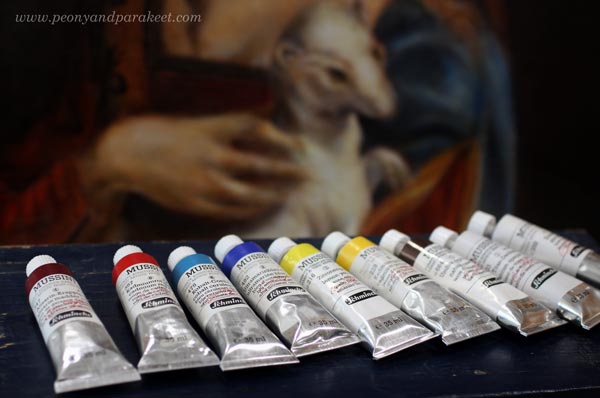
Yesterday, I opened the door of a local art supply store and headed to a specific shelf. On my way to the store, when walking on the narrow streets in the center of Helsinki, I felt it. The feeling that I got a year ago when I opened a tube of Mussini oil paint for the first time. I was attending an art class about old masters painting techniques, and we used the best oil paints I could imagine. Not that I could imagine so much because I had never used oil paints before. But I didn’t expect to experience that strange feeling. It contained both appreciation and excitement. The appreciation of color, and the excitement to learn more from it.
It was not that I would have been new to color. I had been painting with acrylic paints for a long time. When I was a teenager, I got them from my parents who thought that it was a perfect solution to me. No worrying about toxic painting fluids and still being able to paint with ease. The acrylic paints have developed a lot since that time, since the eighties. They have worked perfectly for my needs. I have found a good brand too. I really like Golden acrylics.

But now I was standing in the front of a vast collection of Mussini oil paint tubes. I picked the color chart and went through my choices one more time. For a whole year, I had been going through this in my mind: raw umber, zinc white, titanium white, yellow ochre and so on. It had been a mantra that changed a little bit every month. The paints are expensive, and I had to pick the colors carefully. One tube can cost more than 70 euros.
Plan for the Hand and Mind
After trying out the paints for the first time, I went to live in denial. Yes, I had painted the class pieces with oils because they were provided by the class. But the odorless and water-soluble acrylics felt much more suitable for me. After a while, my attitude changed a bit. I let myself dream about the oil paints. I visited the art supply store, touched the clean and shiny tubes, imagined getting just a bit of paint on a palette and make it last for as long as possible.
But dreaming and reality are surprisingly close. It’s difficult just to dream and not to do anything. So I made a plan that felt more like extortion. I had to get my floral painting class finished. I had to get several acrylic paintings finished. I had to figure out where and how I would store the paints. I had to get more information about the oil paints and the painting liquids.
I still had some finishing touches to do for my paintings in progress, but other than that I had followed the plan. So I started picking the tubes: raw umber, zinc white, titanium white, yellow ochre and so on. After selecting the colors, I went for the liquids: poppy oil, turpentine, and glossy dammar varnish.
When I left the store, my mind summarized the past year. Learning the old masters’ techniques had been essential for growing my technical skills. My art had become less imaginative, and more conventional.
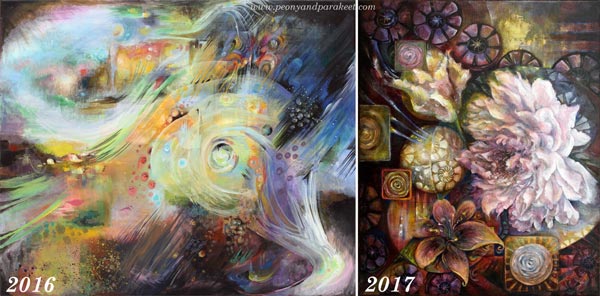
I had a turning point in 2016 when I felt that my imagination and my hand didn’t function so well together anymore. My imagination wanted to proceed to new territories, but my hand couldn’t follow. But now when my hand is wiser, I can also challenge my mind more freely. Purchasing the oil paints were a reward for the persistence that I have had for the last twelve months. However, it wasn’t the only reward. I was also going to see the new movie Loving Vincent.
Loving Vincent – The Movie
The movie theatre was about 10 minutes walk away from the art supply store. When I arrived, there were several queues for the tickets. I joined one. While I was waiting for my turn, a young man suddenly came to me and asked: “Do you want a free ticket? I have two, and my friend wasn’t able to come.” I happily accepted it and thanked the man. “Is this a sign?”, I asked myself. “Is this the final sign that I should do this – go forward, open the tubes, start painting my newest, odd ideas?” I don’t believe in destiny so much, but at that moment, it felt like Vincent van Gogh was talking to me: “Do that, paint those ideas, just like I painted mine.”
I found the movie very emotional. Every time, I saw a familiar painting coming to live, tears came to my eyes. I realized that this movie had to be published now, not earlier. Vincent’s art has become so well-known during the past decades that it unifies us. Art that was odd for masses of the 19th century is understood by every one living the 21st century. It has become so familiar that it’s sometimes difficult to appreciate it. And still, we need to feel the togetherness that Vincent’s paintings can offer. They are like icons that make us stronger together.
Looking back helps us to move forward. As artists, we are all Vincent’s descendants. No matter how we paint, what technique we use, we know about modern art because of Vincent. We know more than the people of the 19th century, and that enables us to explore art to all kinds of directions.
Loving Vincent – Art from the Students
I want to celebrate Vincent by showing beautiful pieces made by my students. They are made from my class Selfie Fantasy that shows an adaptation of Vincent’s technique.
Christie Juhasz:

Terry Whyte:

Denise Dineen:

Gina Meadows:

Patricia Furey:

Stephanie Carney:

Have you seen the movie? What did you think about it?
Imagine Through Art – Buy 5 inspiring mini-courses! (including the Vincent-inspired one)

